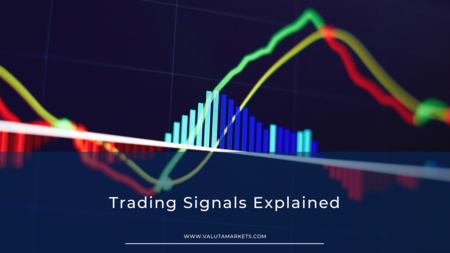A trading signal precipitates market action, either buying or selling a financial asset or security, and is generated by analysis. The latter can be human-generated in the form of technical indicators. It can also be generated through mathematical algorithms based on market action, sometimes in combination with market factors like economic indicators.
Ultimately, trading signals are based on pre-ordained criteria. They can also be applied when reconstituting a portfolio, shifting sector allocations, or taking new positions. You can use different criteria to create your trade signals as a trader. These can be simpler ones like volume surges and earnings reports or complex signals derived from existing signals.
How do trading signals work?
Trading signals can provide data on whether to exit or enter a trade and the best time to do it. They combine single or multiple factors to devise a single trigger. The analysis considers factors such as volume, historical data, and market sentiments when forming predictions of stock market trends known as technical indicators.
You can also incorporate one or multiple technical indicators to attempt and lower the risk of making a trade. Be wary, as using multiple technical indicators can yield highly complex tools, which is counterproductive. Algorithm-based trade signals are programs or apps that analyze the markets to provide data on how to trade.
An “algo signal” is often based on historical trends and movements in the market and in-depth mathematical analysis. Trade signal programs and apps are often developed by third parties who later sell them to traders needing them. Algorithms are only as efficient as the people who create them. Hence you’ll get better results with those developed by people who deeply understand the factors shaping trade movements.
Sometimes, exceptionally made trade signal apps and algorithms are considered economic indicators to guide a trader on current market trends and whether to go long or short on select commodities or stocks. Some platforms even permit traders to create tools that automate their trading.
That is achieved through analyzing market movements and only making trades based on the rules you have instituted in the platform. You’ll probably have better results if you wait for the market to take a certain direction before trading.
Types of trading signals
Trading signals have become appreciated, especially in recent years, as forex trading has become more popular. In today’s market, anyone can start trading in the financial markets with a phone, stable internet, and some money in the bank since deposits are lower. While trading is more accessible today, it is not as simple as most new traders assume.
Long and short trading can be tough, and the markets are sometimes volatile, so some people are just not cut out to become traders. Trade signals come in handy in such situations. There are different types of trading signals.
1. Free signals
Free signals are offered for free or at a fee. Some signal providers offer a combination of both, displaying free signals on their websites. There are caveats to free signals, like the entry price failing to be displayed and traders not being notified when the signal is open. They are a great place to begin if you are a new trader new to the markets, unsure about the service’s performance.
Sometimes, providers offer free trade signals for a test period. Traders try out these signals over a given time, and after seeing the results, they can choose to invest in the service to boost their profits and improve their trades.
2. Paid signals
When you subscribe to a signal provider, you are either charged a flat yearly or monthly subscription fee. It can also be based on a percentage depending on your performance. Your provider will convey information through different avenues based on the software used and your preferences. These include SMS, Skype, email, WhatsApp, etc.
Professional signal providers will explain why the action is the best at the moment, supporting their recommendations with fundamental and technical analyses. In addition to that, sophisticated providers send subscribers updated data to incorporate into their trading decisions.
3. Automated signals
It is a trading signal that you choose to follow by personally executing it or not. An algorithm/trading robot generates it, and seasoned traders use it as an additional source of market analysis.
4. Manual signals
These are issued by pro traders who have a deep knowledge of the financial markets. Such professionals typically carry out fundamental and technical analyses to back their recommendations. Most people find manual signals superior because experienced traders consider all factors affecting currency pairs.
Conclusion
Trading signals are undoubtedly worth considering, but only if they are reliable. Any trading signals providers can offer software. However, to ensure you receive quality signals, work with sources with the right credentials, as it lowers your risk of being pointed in the wrong direction.

